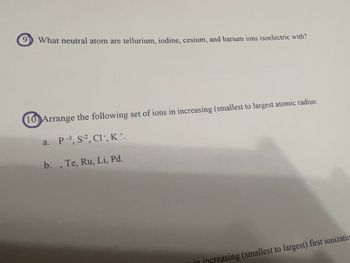
Chemistry
10th Edition
ISBN: 9781305957404
Author: Steven S. Zumdahl, Susan A. Zumdahl, Donald J. DeCoste
Publisher: Cengage Learning
expand_more
expand_more
format_list_bulleted
Question

Transcribed Image Text:What neutral atom are tellurium, iodine, cesium, and barium ions isoelectric with?
10 Arrange the following set of ions in increasing (smallest to largest atomic radius:
a. P-3, S-2, Cl-, K+.
b., Te, Ru, Li, Pd.
in increasing (smallest to largest) first ionizatio
Expert Solution
This question has been solved!
Explore an expertly crafted, step-by-step solution for a thorough understanding of key concepts.
Step by stepSolved in 5 steps with 3 images

Knowledge Booster
Learn more about
Need a deep-dive on the concept behind this application? Look no further. Learn more about this topic, chemistry and related others by exploring similar questions and additional content below.Similar questions
- An element that has the valence electron configuration 4s24p4 belongs to which period and group? O a. period 5; group 18 O b. period 5; group 6 c. period 4; group 8 O d. period 4; group 6 e. period 4; group 16arrow_forwardWhich of the following species are isoelectronic (same electron configuration) with argon? Ca2+ Ge4+ Cl- Options: A. Ca2+, Ge4+ and Cl- B. Ca2+ and Ge4+ C. Ge4+ and Cl- D. Ca2+ and Cl- *I think it's B?arrow_forwardPlace the following elements in increasing order (lowest to highest) according to the trend. Text a. lonization Energy Ca, Se, Br, Ga b. Reactivity Ca, Be, Sr, Ba, Mgarrow_forward
- Write the full electron configuration of the ion oxide, O2- You can indicate superscript through the ^ symbol (e.g. 3s2 could be written as 3s^2) or use the superscript text formatting tool above.arrow_forwardWhich of the following species is diamagnetic (not paramagnetic): Li, V, Ni, Zn, Fe2+ Select one: a. Fe2+ b. V c. Li d. Ni e. Znarrow_forward4. Which one of the following elements has a +2 ion with 2 unpaired electrons? Be Ge Co Ni Fearrow_forward
- Identify each element below. „La).[Ar.].4s?3 (b) [Xe] 6s²4A45d2 (c) [Xe] 6s²5d104f146p3arrow_forwardPlease answer very soonarrow_forward18. Write the full and abbreviated electron configurations for molybdenum. How many core and valence electrons does it have? Isoei gniwallot srit shA: 36; 6arrow_forward
- Which of the following is the electron configuration of the iron(II) ion (Fe2+)? Select one: a. [Ar]4s23d9 b. [Ar]4s23d2 c. [Ar]4s13d5 d. [Ar]3d6 e. [Ar]3d5 Clear my choicearrow_forwardWhich of the following represent the proper long hand form electron configuration of molybdenum, Mo, using the building-up principle? answer choices A. [Kr] 4d4 5s2 B. [Kr] 5s2 4d4 C. 1s2 2s2 2p6 3s2 3p6 3d10 4s2 4p6 5s2 4d4 D. 1s2 2s2 2p6 3s2 3p6 4s2 3d10 4p6 5s2 4d4 E. 1s2 2s2 2p6 3s2 3p6 3d10 4s2 4p6 4d4 5s2arrow_forwardWhich of the options below provides a reason why the covalent radius of hafnium (1.44 Å) is less than that of zirconium (1.45 Å), even though the element above it in the periodic table? A. Between Zr and Hf lies the 4d10 configuration due to the transition metals. This leads to much greater Z* because the d electrons are so poor at shielding. Thus Hf is smaller than expected for an element in a higher shell than Zr, called the Scandide contraction. B. Hf being below Zr suggests that it will have a smaller atomic radius because the trend shows a decrease going down a group. C. Hf is below Zr and has a smaller ionisation energy, electron affinity and electronegativity compared to Zr. This reduces its atomic radius, thus leading to it having a smaller atomic radius compared to that of Zr. D. Between Zr and Hf lies the 4f14 configuration due to the Lanthanides. This leads to much greater Z* because the f electrons are so poor at shielding. Thus Hf is smaller than expected for an element in…arrow_forward
arrow_back_ios
SEE MORE QUESTIONS
arrow_forward_ios
Recommended textbooks for you
 ChemistryChemistryISBN:9781305957404Author:Steven S. Zumdahl, Susan A. Zumdahl, Donald J. DeCostePublisher:Cengage Learning
ChemistryChemistryISBN:9781305957404Author:Steven S. Zumdahl, Susan A. Zumdahl, Donald J. DeCostePublisher:Cengage Learning ChemistryChemistryISBN:9781259911156Author:Raymond Chang Dr., Jason Overby ProfessorPublisher:McGraw-Hill Education
ChemistryChemistryISBN:9781259911156Author:Raymond Chang Dr., Jason Overby ProfessorPublisher:McGraw-Hill Education Principles of Instrumental AnalysisChemistryISBN:9781305577213Author:Douglas A. Skoog, F. James Holler, Stanley R. CrouchPublisher:Cengage Learning
Principles of Instrumental AnalysisChemistryISBN:9781305577213Author:Douglas A. Skoog, F. James Holler, Stanley R. CrouchPublisher:Cengage Learning Organic ChemistryChemistryISBN:9780078021558Author:Janice Gorzynski Smith Dr.Publisher:McGraw-Hill Education
Organic ChemistryChemistryISBN:9780078021558Author:Janice Gorzynski Smith Dr.Publisher:McGraw-Hill Education Chemistry: Principles and ReactionsChemistryISBN:9781305079373Author:William L. Masterton, Cecile N. HurleyPublisher:Cengage Learning
Chemistry: Principles and ReactionsChemistryISBN:9781305079373Author:William L. Masterton, Cecile N. HurleyPublisher:Cengage Learning Elementary Principles of Chemical Processes, Bind...ChemistryISBN:9781118431221Author:Richard M. Felder, Ronald W. Rousseau, Lisa G. BullardPublisher:WILEY
Elementary Principles of Chemical Processes, Bind...ChemistryISBN:9781118431221Author:Richard M. Felder, Ronald W. Rousseau, Lisa G. BullardPublisher:WILEY

Chemistry
Chemistry
ISBN:9781305957404
Author:Steven S. Zumdahl, Susan A. Zumdahl, Donald J. DeCoste
Publisher:Cengage Learning

Chemistry
Chemistry
ISBN:9781259911156
Author:Raymond Chang Dr., Jason Overby Professor
Publisher:McGraw-Hill Education

Principles of Instrumental Analysis
Chemistry
ISBN:9781305577213
Author:Douglas A. Skoog, F. James Holler, Stanley R. Crouch
Publisher:Cengage Learning

Organic Chemistry
Chemistry
ISBN:9780078021558
Author:Janice Gorzynski Smith Dr.
Publisher:McGraw-Hill Education

Chemistry: Principles and Reactions
Chemistry
ISBN:9781305079373
Author:William L. Masterton, Cecile N. Hurley
Publisher:Cengage Learning

Elementary Principles of Chemical Processes, Bind...
Chemistry
ISBN:9781118431221
Author:Richard M. Felder, Ronald W. Rousseau, Lisa G. Bullard
Publisher:WILEY